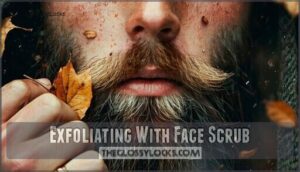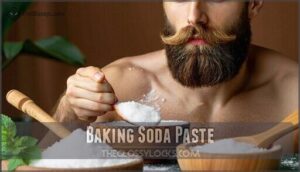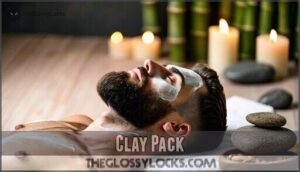This site is supported by our readers. We may earn a commission, at no cost to you, if you purchase through links.
 Beard itch relief home remedies can transform your scratchy situation into smooth sailing.
Beard itch relief home remedies can transform your scratchy situation into smooth sailing.
Start with daily washing using a gentle beard shampoo to remove dirt and dead skin cells.
Apply beard oil after washing to moisturize both hair and skin underneath.
Exfoliate weekly with a soft scrub to prevent ingrown hairs.
Natural solutions like aloe vera gel provide cooling relief, while diluted apple cider vinegar balances skin pH.
Tea tree oil fights bacterial infections that worsen itching.
Don’t forget proper brushing with a boar bristle brush to distribute natural oils evenly.
These simple steps tackle the root causes rather than just masking symptoms, setting you up for long-term comfort and healthier facial hair growth.
Table Of Contents
- Key Takeaways
- Causes of Itchy Beard
- Home Remedies for Relief
- Preventing Itchy Beard
- Natural Solutions for Itch
- Managing Chronic Itch
- Frequently Asked Questions (FAQs)
- What does it mean if your beard is itchy?
- Which oil is best for an itchy beard?
- Does coconut oil stop beard itch?
- How do you get rid of a Itchy beard at home?
- What are the best beard home remedies?
- Does apple cider vinegar help a beard itch?
- Does peppermint oil help a Itchy beard?
- How to prevent a beard itch?
- Does Beard oil help itch?
- What can I put on my beard to stop itching?
- Conclusion
Key Takeaways
- Clean your beard daily with gentle beard shampoo to remove dirt, dead skin cells, and bacteria that cause irritation and itching.
- Apply beard oil after washing to moisturize both your facial hair and the skin underneath, preventing dryness that triggers uncomfortable scratching.
- Exfoliate weekly with a soft scrub to prevent ingrown hairs and remove buildup that clogs pores and worsens beard itch.
- Try natural remedies like aloe vera gel for cooling relief, diluted apple cider vinegar to balance skin pH, or tea tree oil to fight bacterial infections causing persistent itching.
Causes of Itchy Beard
You’re dealing with an itchy beard, and several factors could be behind that annoying scratch.
The most common culprits include sharp hair edges from recent trimming, dry skin underneath your beard, ingrown hairs, seborrheic eczema, and folliculitis.
Sharp Hair Edges
Sharp edges from razor cuts scratch your hair follicle as beard hairs regrow.
These stiff, upright ends cause significant irritation and trigger the dreaded itch phase.
Regular beard trimming and edge control through hair edge smoothening techniques prevent this abrasive cycle.
Conditioning treatments soften sharp ends, providing effective beard itch relief home remedies for lasting comfort.
Understanding folliculitis causes is essential to addressing the root of beard itch and related skin conditions, which can lead to folliculitis.
Dry Skin
Your skin beneath the beard needs moisture to stay healthy.
When dry skin develops, it creates flaky patches that trigger intense itching.
Cold weather and harsh soaps strip away natural oils, leaving your skin parched.
This dryness causes irritation relief to become your top priority.
Proper skin care with moisturizing tips prevents these uncomfortable dry patches from forming, and maintaining healthy skin is crucial, which is why proper skin care is essential.
Ingrown Hairs
Curly complications arise when hair follicles redirect growth beneath your skin’s surface.
These wayward whiskers create red bumps and skin inflammation that trigger persistent itching.
Hair removal techniques often worsen ingrown symptoms by creating sharp edges. Your follicles trap these redirected hairs, causing tender spots that demand immediate beard itch relief through targeted home remedies for beard itch.
Seborrheic Eczema
Beyond ingrown hairs, seborrheic eczema creates persistent beard itch through chronic skin inflammation.
This condition thrives in oily facial areas, causing flaky skin and redness that demands targeted eczema treatment.
Key seborrheic eczema triggers include:
- Malassezia yeast overgrowth – Creates inflammatory response requiring antifungal scalp care approaches
- Compromised skin barrier – Leads to increased sensitivity and persistent redness relief needs
- Stress and seasonal changes – Worsen flare-ups, making natural itch relief essential
Understanding the seborrheic dermatitis causes is vital for effective treatment.
Effective beard itch home remedies focus on gentle cleansing and moisture restoration for lasting comfort.
Folliculitis
When bacteria invade your hair follicles, you’re dealing with folliculitis—a common skin infection that triggers intense itching.
Bacterial invasion turns your hair follicles into itchy battlegrounds demanding immediate attention.
This condition creates red, inflamed bumps around individual follicles, making your beard feel like a battlefield.
| Bacterial Causes | Fungal Treatment | Follicle Care |
|---|---|---|
| Staph bacteria | Antifungal creams | Gentle cleansing |
| Pseudomonas | Tea tree oil | Proper hydration |
| Strep infections | Zinc pyrithione | Regular trimming |
Proper follicle care prevents bacterial overgrowth.
Natural remedies for beard itch include antimicrobial oils and gentle exfoliation to keep pores clear.
Home Remedies for Relief
You can find relief from beard itch using simple home remedies that target the root causes.
These natural solutions work by moisturizing your skin, reducing inflammation, and keeping your facial hair clean and manageable.
Washing With Beard Shampoo
Regular beard shampoo washing provides effective beard itch relief by removing irritating buildup and dead skin cells.
Choose specialized beard shampoo over harsh soap alternatives that strip natural oils.
Apply gentle cleansing tips: massage thoroughly, rinse completely, and follow with conditioning.
This simple home remedy for beard itch creates the foundation for comfortable facial hair maintenance.
Using an organic beard care routine can help maintain a healthy beard and reduce itchiness.
Exfoliating With Face Scrub
Exfoliation removes dead skin cells that trap bacteria and irritants beneath your beard. This gentle cleansing process promotes skin renewal and reduces inflammation.
Apply a beard scrub twice weekly using circular motions to prevent clogged pores and ingrown hairs. Regular use of a beard care product can help maintain healthy skin underneath the beard.
- Dead skin flakes falling away like autumn leaves
- Smooth, refreshed skin emerging underneath coarse hair
- Circular massage motions working deep into follicles
- Clean pores breathing freely after thorough cleansing and resulting in refreshed skin
Using Beard Oil
After washing your beard, beard oil becomes your ultimate weapon against persistent itch.
This powerful remedy hydrates both facial hair and underlying skin while reducing inflammation. For ideal beard health, using high-quality beard oil products from a reliable beard oil relief source is essential.
| Oil Type | Primary Benefit |
|---|---|
| Jojoba Oil | Mimics natural skin oils |
| Argan Oil | Provides antioxidants and vitamins |
| Tea Tree Oil |
Offers anti-inflammatory properties.
Apply 2-3 drops daily after showering. Massage thoroughly into beard roots and skin for maximum absorption and itch relief.
Conditioning The Beard
Conditioning treatments provide deep beard nourishment beyond surface-level beard oil application.
Quality conditioners deliver targeted beard hydration while promoting beard softening through specialized ingredients.
Apply conditioner after shampooing to maximize beard protection and moisture retention.
Leave the product in for recommended time periods to achieve ideal beard conditioning results.
This approach enhances your beard itch relief home remedies routine effectively.
Using a good beard conditioner product is essential for maintaining healthy beard hair.
You can find a suitable product through this conditioner product link to support your beard care routine.
Applying Apple Cider Vinegar
Apple cider vinegar’s antimicrobial properties combat beard itch by restoring skin’s natural pH balance.
Nature’s vinegar balances your skin’s pH and fights the bacteria causing your beard itch.
Mix equal parts ACV and water, then apply with cotton pad. This ACV treatment provides itch relief through skin soothing action.
The acidic solution removes buildup while delivering vinegar benefits for beard care. These DIY beard itch remedies offer natural solutions, providing itch relief and utilizing ACV treatment.
Preventing Itchy Beard
Prevention starts with consistent daily habits that address the root causes of beard irritation.
Simple maintenance steps like regular trimming and proper hygiene create the foundation for long-term comfort and healthy facial hair growth, which is key to healthy beard care.
Trimming The Beard
Regular beard trimming cuts away sharp edges that scratch your skin and cause irritation.
Use quality clippers with guards to maintain consistent length. Trim every few weeks to prevent split ends and reduce debris buildup.
This simple beard maintenance technique removes damaged hair while promoting healthier growth patterns and better product absorption.
Brushing The Beard
Daily beard brushing transforms your facial hair from a scratchy mess into smooth, manageable growth.
This beard care ritual distributes natural oils while removing dead skin cells that trigger irritation.
Choose natural bristle brush types for gentle beard maintenance tips.
Consistent beard brushing in your daily routine prevents tangles and promotes healthy beard growth.
This simple beard itch relief method costs nothing but delivers immediate comfort.
Using Beard Comb
A quality beard comb transforms tangled facial hair into smooth, manageable growth.
Choose wooden or horn materials for gentle beard detangling without static buildup.
Start combing from beard tips, working upward to prevent painful pulls.
Proper comb techniques distribute natural oils evenly, reducing irritation and dryness.
Regular beard maintenance with appropriate tools prevents matting and promotes healthier follicles.
Using a beard care kit with a beard comb tool can help achieve ideal beard health and appearance.
Applying Beard Balm
Beard balm offers powerful itch relief through moisturizing ingredients like shea butter and beeswax.
These balm ingredients create a protective barrier while conditioning facial hair.
Apply balm after washing, working it through damp whiskers.
Different skin types benefit from specific formulations, and natural beard itch remedies work best when balm complements your beard care routine, providing lasting comfort.
Maintaining Proper Hygiene
Clean skin supports healthy hair follicles and prevents irritation. Good beard hygiene tips form the foundation of effective beard itch relief methods. Your daily routine should include gentle facial massage to stimulate circulation.
Key practices for ideal skin care:
- Wash your beard twice daily with lukewarm water
- Pat dry gently to avoid damaging hair follicles
- Apply moisturizer to underlying skin regularly
These home remedies for beard itch work best with consistent beard cleaning habits.
Natural Solutions for Itch
When store-bought remedies fall short, nature offers gentle alternatives that can soothe your irritated facial hair.
These natural solutions work by reducing inflammation and providing antimicrobial benefits to calm your skin beneath the beard, offering a gentle approach to skin care.
Aloe Vera Gel
Nature’s cooling remedy offers immediate relief for irritated facial skin.
Aloe vera gel contains anti-inflammatory compounds that reduce redness and calm inflamed hair follicles.
Apply fresh gel directly to your beard area twice daily.
The natural moisturizing properties prevent dryness while promoting healthy skin regeneration.
This gentle treatment provides effective beard itch relief without harsh chemicals or expensive products.
Peppermint Leaves
Fresh peppermint leaves offer immediate cooling relief from irritated facial hair. Crush leaves and rub the soothing juice onto itchy spots for instant comfort.
These natural soothers contain menthol compounds that calm inflamed skin and reduce irritation.
- Apply crushed peppermint leaves directly to affected areas
- Steep leaves in hot water for a rejuvenating rinse
- Mix leaf extract with carrier oils for enhanced penetration
- Create a cooling compress using fresh mint benefits
- Combine with other herbal remedies for stronger relief
Baking Soda Paste
Baking soda creates an alkaline environment that neutralizes acidity-causing bacteria.
Mix equal parts baking soda and water to form a thick paste. Apply gently to affected areas for five minutes before rinsing.
This Paste Recipe provides effective Itch Relief through pH balancing properties.
| Soda Benefits | Application Method | Skin Soothing Effects |
|---|---|---|
| Neutralizes pH levels | Apply for 5 minutes | Reduces inflammation |
| Kills bacteria | Rinse with cool water | Calms irritated follicles |
| Gentle exfoliation | Use 2-3 times weekly | Prevents future breakouts |
Clay Pack
Beyond scrubbing with baking soda, clay masks offer powerful skin detox benefits for beard itch relief home remedies.
Bentonite or kaolin clay draws out impurities while providing natural exfoliant properties.
Mix clay powder with water, apply to your beard area, and let it work its magic for ten minutes.
These herbal remedies and face masks help calm irritated follicles naturally, and can be part of your beard care routines to reduce itchiness and promote healthy skin, as seen in methods for beard care routines to reduce itchiness and promote healthy skin with natural exfoliant properties.
Tea Tree Oil
Tea tree oil stands out among beard itch relief home remedies for its proven antimicrobial and anti-inflammatory properties.
This essential oil contains terpinen-4-ol, which fights bacteria that cause folliculitis and beard irritation.
When diluted properly with carrier oils like jojoba, tea tree oil soothes inflamed skin while providing natural remedies for beard itch.
Always patch test first, as some people experience allergic reactions to this potent oil.
Managing Chronic Itch
When home remedies aren’t cutting it, you might be dealing with chronic beard itch that needs professional attention.
A dermatologist can identify underlying skin conditions and prescribe targeted treatments that actually work.
Consulting a Dermatologist
When should you seek professional skin care advice for persistent beard itch? A dermatologist visit becomes essential when home remedies fail after two to three weeks of consistent use.
Here are three critical warning signs requiring medical advice:
- Pus or open sores – These indicate possible infection needing prescription itch treatment
- Hair loss patches – Signal underlying conditions affecting beard health beyond surface irritation
- Sleep disruption – Chronic itching impacting daily life requires specialized beard itch relief methods
Dermatologists diagnose beard itch causes through visual inspection and laboratory tests when needed. They differentiate between conditions like folliculitis, seborrheic dermatitis, and fungal infections that share similar symptoms but require different beard itch remedies.
Professional evaluation prevents complications like scarring or secondary infections while providing targeted beard itch treatment options unavailable over-the-counter.
Using Medications
When home remedies fall short, prescription medications offer targeted relief.
Topical corticosteroid creams reduce inflammation while antifungal ointments tackle yeast overgrowth.
Oral antibiotics combat bacterial folliculitis when pill treatments become necessary.
Medicated sprays provide convenient application for widespread irritation.
Your dermatologist will recommend appropriate medication options based on your specific condition, ensuring effective beard itch treatment through proven pharmaceutical solutions.
Trying Photodynamic Therapy
Photodynamic therapy combines light therapy with photosensitizing agents to target chronic beard inflammation.
This specialized treatment requires dermatologist supervision and involves controlled light exposure after applying medication.
Photo sensitivity follows each session, demanding strict sun avoidance.
While therapy sessions show promising treatment outcomes for severe folliculitis, skin reactions can occur.
Consider this advanced option when beard itch relief home remedies fail completely, as it may provide the necessary relief for severe folliculitis.
Laser Hair Removal
Laser Treatment offers permanent removal for severe beard itch cases.
This Follicle Destruction method uses targeted light beams to eliminate problematic hair follicles.
Hair Reduction sessions typically require multiple visits but provide lasting relief.
Skin Rejuvenation benefits accompany treatment.
Consider this option when beard itch relief home remedies fail to control chronic symptoms.
Frequently Asked Questions (FAQs)
What does it mean if your beard is itchy?
Feeling that mysterious itch creeping in? Your beard’s rebellion likely signals dry skin, ingrown hairs, or folliculitis. It’s common whether you’re growing your first beard or maintaining years-old whiskers.
Which oil is best for an itchy beard?
Jojoba oil stands out as your best option for taming beard itch.
It closely resembles our skin’s natural sebum, making it a wonderful choice for sensitive skin types and helps to control beard dandruff and reduce itchiness.
You’ll find relief quickly, as it helps to control beard dandruff and reduce itchiness with jojoba oil.
Does coconut oil stop beard itch?
Studies show 75% of men experience beard itch during growth.
Yes, coconut oil can help stop beard itch by moisturizing skin and reducing dryness.
Its antibacterial properties combat dandruff and flakiness. Use sparingly to avoid clogged pores.
How do you get rid of a Itchy beard at home?
You’ll banish that itchy beard quickly by washing it with gentle beard shampoo, applying natural oils like jojoba or argan, keeping it moisturized, and resisting the urge to scratch constantly.
What are the best beard home remedies?
Coconut oil’s antimicrobial properties might fight bacterial causes of beard irritation. Regular washing with warm water prevents oil and dirt buildup. Exfoliating removes dead skin cells, tackling root causes systematically.
Does apple cider vinegar help a beard itch?
Apple cider vinegar can help reduce beard itch by restoring pH balance and cleansing irritated skin. Dilute it properly – one part vinegar to four parts water.
Does peppermint oil help a Itchy beard?
Peppermint oil can reduce your beard itch through its natural cooling properties. It provides anti-inflammatory benefits that soothe irritated skin and reduce redness. Always dilute before applying directly.
How to prevent a beard itch?
Maintain good hygiene habits to prevent beard itch. Wash your beard regularly with gentle cleanser, moisturize daily with beard oil or balm, and avoid harsh soaps that strip natural oils.
Does Beard oil help itch?
Yes, beard oil effectively reduces itch.
It moisturizes dry skin beneath your beard and softens coarse hair.
Quality oils contain nourishing ingredients that soothe irritation and prevent flaking, giving you comfort while promoting healthier growth.
What can I put on my beard to stop itching?
You can apply beard oil, balm, or conditioner to moisturize dry skin underneath. Try natural remedies like coconut oil or jojoba oil. Regular washing with gentle beard shampoo helps too.
Conclusion
Beardsmen everywhere finally have scientific backup for what they’ve suspected all along – scratching your face constantly isn’t dignified.
These beard itch relief home remedies tackle the root causes through proper cleansing, moisturizing, and maintenance routines.
From beard oils to natural antiseptics, you’ve got evidence-based options that won’t break the bank.
Start with gentle daily washing and consistent oil application to deliver lasting comfort, as your face deserves better than constant irritation, and these methods deliver lasting comfort.
- https://neofollics.com/blogs/articles/itchy-beard
- https://www.gillette.co.uk/blog/how-to-shave/how-to-stop-an-itchy-beard/
- https://www.aad.org/public/everyday-care/skin-care-secrets/face/diy-treatment-common-beard-problems
- https://australianskinclinics.com.au/blog/how-to-soothe-an-itchy-beard/
- https://detroitgrooming.com/blogs/313-beard-blog/stop-scratching-effective-solutions-to-soothe-your-itchy-beard















